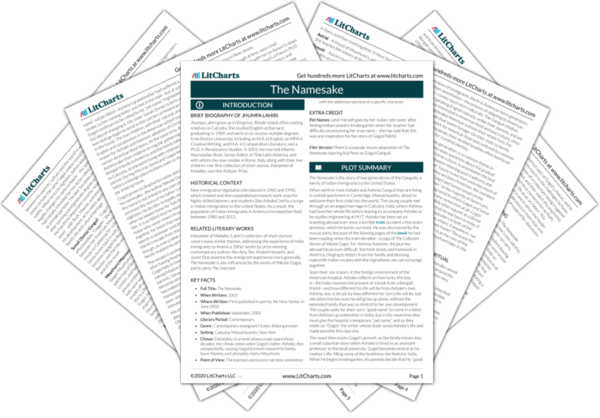Books play an important role in many key scenes in the novel, beginning in the first chapter with the young Ashoke’s all-consuming love for them—a love that saves his life, and gives Gogol his name—and ending with Gogol’s chance discovery of the book his father had given him for his birthday more than a decade before. Books are records of the past and carriers of names, as in the case of Moushumi’s inscribed books from Graham or Dimitri, or Ashima’s books of addresses. They also can grant a reader the power to travel—an idea made literal by Gogol’s purchase of an Italian guidebook.
Books Quotes in The Namesake
The The Namesake quotes below all refer to the symbol of Books. For each quote, you can also see the other characters and themes related to it (each theme is indicated by its own dot and icon, like this one:
).
Chapter 2
Quotes
“Lucky boy,” Ashoke remarks, turning the beautifully sewn pages. “Only a few hours old and already the owner of books.” What a difference, he thinks, from the childhood he has known. Ashima thinks the same, though for different reasons. For as grateful as she feels for the company… these acquaintances are only substitutes for the people who really ought to be surrounding them. Without a single grandparent or parent or uncle or aunt at her side, the baby’s birth, like most everything else in America, feels somehow haphazard, only half true. As she strokes and suckles and studies her son, she can’t help but pity him. She has never known of a person entering the world so alone, so deprived.
Related Characters:
Related Symbols:
Page Number and Citation:
Explanation and Analysis:
Get the entire The Namesake LitChart as a printable PDF.

Books Symbol Timeline in The Namesake
The timeline below shows where the symbol Books appears in The Namesake. The colored dots and icons indicate which themes are associated with that appearance.
Chapter 1
...that Ashoke read to him. He promised that Ashoke could take his collection of antique books home with him afterward—a treasure Ashoke had long desired.
(full context)
On the journey to his grandparents’ home in the North, Ashoke brings only one book—a collection of short stories by Nikolai Gogol that his grandfather had given him upon his...
(full context)
...wreckage and unable to call out. It is only when the fluttering pages of his book finally attract the attention of a rescuer that he is found, still clutching one page.
(full context)
...haunted his sleep, he read late at night, but he would no longer touch the novels of his childhood. Instead, he read his engineering texts, keeping up with schoolwork as best...
(full context)
...ancestors for this bounty, for his nearly newborn child, and to Gogol, the writer whose book saved his life. At this moment, Patty enters the room.
(full context)
Chapter 2
...have met in Cambridge. Dr. Gupta, a post-doc at M.I.T., gives the baby an illustrated book of Mother Goose rhymes, which Ashoke appreciates, marveling at how different this boy’s childhood will...
(full context)
...the one glimpse of their apartment Ashima has had horrified her with its clutter of books, bottles, and dirty plates.
(full context)
Chapter 3
...signature at the bottom of every art piece, and in the front cover of his textbooks.
(full context)
Chapter 4
...ended, but Ashima points out that they have no relatives in America. So they leave, textbooks packed and shipped away to an address—his father’s home in Calcutta—that makes Gogol uneasy.
(full context)
...in with their old lives while the children feel like outcasts. Sonia has read the books she brought dozens of times by the end of their stay. Gogol brought his sneakers,...
(full context)
...care. Gogol has refused to read the assigned short story, and he never opened the book his father gave him on his birthday.
(full context)
Chapter 6
...lakeside house down a remote dirt road and find Gerald and Lydia, lounging with their books. Gogol and Maxine take up residence in a small, unfinished cabin outside the main house....
(full context)
Chapter 7
...table, addressing Christmas cards to her Bengali friends, the names spread across three different address books that chronicle their life in America. While she usually buys discounted, secular holiday cards, this...
(full context)
...cards, each with her husband’s name, and then finds her son’s number in the address book—under G for Ganguli and for Gogol.
(full context)
Chapter 8
Moushumi is waiting for him in a bar in the East Village, reading a book in French. Their conversation starts with a discussion of his new name, and the fact...
(full context)
Chapter 10
...“D”—without the name, it doesn’t feel like a betrayal. At home, she searches out a book Dimitri had inscribed to her by Stendhal, unable at first to find it in the...
(full context)
...by how easy it feels. Left alone in Dimitri’s apartment one day, she scans his bookshelves, recognizing many titles. She takes out a book of photographs of Paris by Atget, looking...
(full context)
Chapter 11
Inspired by the idea of planning a trip to Italy, Gogol buys Moushumi a guidebook and begins to walk home, frightened momentarily by a flock of pigeons that seem strangely...
(full context)
Chapter 12
...has yet to clean out the room. Ashima has warned him that all of his books will be donated to the library where she works. Gogol pokes through a box of...
(full context)
Gogol closes the door and sits down with the book, which has been saved as if by chance from being lost, just as Ashoke had...
(full context)
Gogol opens to the first story in the book, “The Overcoat.” Soon Ashima will come to find him, wondering where he has been, scolding...
(full context)














